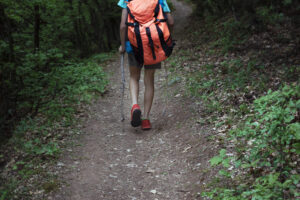During these warm weather months, more time outdoors means more exposure to insects and ticks that can spread diseases and cause illness. Although commonly called “insects,” ticks are actually arachnids (like spiders). While most tick bites are harmless, it’s worthwhile to understand possible risks associated with tick exposure and how to treat and prevent tick bites. Many tick bites go unnoticed, as they are typically not painful or itchy. Additionally, some species of ticks are very small (the size of a poppy seed) and some embed in the scalp or hairline where they can be hard to see. Most tick-borne diseases are not caused by the ticks themselves, but by the bacteria, viruses, or parasites they can transmit.
 Lyme disease is the most prevalent tick-borne illness in the US and is caused by the bacteria Borrelia burgdorferi. Two species of Ixodes or “deer ticks” are the most common vectors. Although cases of Lyme have been reported in 48 states, the vast majority occur in the northeast coastal regions, Upper Midwest (Wisconsin and Michigan), and West Coast including northern California. Even in high-risk areas, the risk of Lyme disease after a tick bite is only 2%. Although Lyme disease can present in many ways, up to 80% of patients develop a circular, red rash which evolves into a bullseye at the bite site 1-2 weeks after exposure. This rash, known as erythema migrans (EM), is the early localized phase of Lyme disease and usually resolves after 2-3 weeks. The rash can be accompanied by headache, fever, chills, fatigue, swollen lymph nodes, and muscle/joint aches. The second stage (early disseminated) commonly includes widespread and multiple EM rash lesions. Some patients may also have heart or neurologic symptoms, such as facial paralysis or meningitis. The third (late disseminated) phase of Lyme, occurring months after infection, is most notable for episodic arthritis. Chronic arthritis is rare in children, as are late central nervous symptoms (memory impairment, chronic fatigue, behavioral changes).
Lyme disease is the most prevalent tick-borne illness in the US and is caused by the bacteria Borrelia burgdorferi. Two species of Ixodes or “deer ticks” are the most common vectors. Although cases of Lyme have been reported in 48 states, the vast majority occur in the northeast coastal regions, Upper Midwest (Wisconsin and Michigan), and West Coast including northern California. Even in high-risk areas, the risk of Lyme disease after a tick bite is only 2%. Although Lyme disease can present in many ways, up to 80% of patients develop a circular, red rash which evolves into a bullseye at the bite site 1-2 weeks after exposure. This rash, known as erythema migrans (EM), is the early localized phase of Lyme disease and usually resolves after 2-3 weeks. The rash can be accompanied by headache, fever, chills, fatigue, swollen lymph nodes, and muscle/joint aches. The second stage (early disseminated) commonly includes widespread and multiple EM rash lesions. Some patients may also have heart or neurologic symptoms, such as facial paralysis or meningitis. The third (late disseminated) phase of Lyme, occurring months after infection, is most notable for episodic arthritis. Chronic arthritis is rare in children, as are late central nervous symptoms (memory impairment, chronic fatigue, behavioral changes).
 Most patients treated with appropriate antibiotics in the early stages of Lyme disease will make a full and speedy recovery. Blood tests can be done to detect antibodies to the Lyme-causing bacteria, but these tests can be falsely negative in the first few weeks of illness. Because of this, many patients are diagnosed without confirmatory testing if they have a classic EM rash after spending time in an area where Lyme disease is common. In some situations, preventive antibiotics may be indicated for your child after a known tick bite in a region where Lyme disease is prevalent. The decision to treat is case-specific and depends on area of travel, length of tick attachment, and degree of tick engorgement.
Most patients treated with appropriate antibiotics in the early stages of Lyme disease will make a full and speedy recovery. Blood tests can be done to detect antibodies to the Lyme-causing bacteria, but these tests can be falsely negative in the first few weeks of illness. Because of this, many patients are diagnosed without confirmatory testing if they have a classic EM rash after spending time in an area where Lyme disease is common. In some situations, preventive antibiotics may be indicated for your child after a known tick bite in a region where Lyme disease is prevalent. The decision to treat is case-specific and depends on area of travel, length of tick attachment, and degree of tick engorgement.
Rocky Mountain Spotted Fever (RMSF) is a tick-borne infection caused by the bacteria Rickettsia rickettsii and spread by dog and wood ticks. This infection is disproportionately seen in children and teens under 15 years of age. Despite the name, RMSF is most common in the mid-Atlantic and southern states. In the past 20 years, increasing cases have also been reported in the Southwestern US (Arizona). RMSF can be rapidly fatal if not treated within the first 5 days of illness onset. But with appropriate and early antibiotic treatment, the prognosis is good. In the first few days of illness, RMSF typically presents with high fever, headache, muscle/joint aches, fatigue, and nausea/vomiting. The typical rash usually erupts between days 2-6 and appears as red, dot-like spots around the wrists and ankles, which then spread to the trunk.
 Tick paralysis is a rare, non-infectious illness that can present acutely and dramatically in children. It is caused by a salivary neurotoxin produced by engorged, female ticks. In North America, the most common offenders are the American dog tick and Rocky Mountain wood tick. Symptoms of fatigue, weakness, and unsteady gait typically start 3-7 days after tick attachment. Weakness and paralysis start in the legs, then quickly progress up the body. Once the tick is removed, symptoms resolve within hours!
Tick paralysis is a rare, non-infectious illness that can present acutely and dramatically in children. It is caused by a salivary neurotoxin produced by engorged, female ticks. In North America, the most common offenders are the American dog tick and Rocky Mountain wood tick. Symptoms of fatigue, weakness, and unsteady gait typically start 3-7 days after tick attachment. Weakness and paralysis start in the legs, then quickly progress up the body. Once the tick is removed, symptoms resolve within hours!
Tick-related illnesses are relatively rare, but tick bites in children are quite common so prevention is our first line of defense. When hiking or playing in wooded areas, stay on marked trails, cover exposed skin with clothing, wear closed shoes, and don a hat. Tick-repellants such as permethrin can be used only on clothing. DEET-containing repellants are very effective and can be used on exposed skin in children as young as 2 months of age. When returning home from tick-infested areas, perform a head-to-toe tick check on your child (and pets), including behind the ears and on the scalp. Bathing immediately can help remove loose ticks, since they often take 4-6 hours to firmly attach to skin. You can also put clothing in the dryer on high temperature for 10 minutes to help remove unwanted tag-a-longs.
 Ticks are most safely and effectively removed using clean tweezers to grasp the tick close to the skin, then pull straight upward without twisting or crushing the tick. If the tick head breaks off in the skin, you can use clean tweezers or a needle to uncover the head and scrape off. If the tick is too small to grasp with tweezers, you can use the edge of a credit card to scrape it off the skin. Once the tick is removed, keep the wound clean with soap and water and apply a topical antibiotic ointment. A small bump can remain under the skin, but typically resolves after a few days. You may also note mildly swollen and tender lymph nodes in the area for days to weeks after a tick bite.
Ticks are most safely and effectively removed using clean tweezers to grasp the tick close to the skin, then pull straight upward without twisting or crushing the tick. If the tick head breaks off in the skin, you can use clean tweezers or a needle to uncover the head and scrape off. If the tick is too small to grasp with tweezers, you can use the edge of a credit card to scrape it off the skin. Once the tick is removed, keep the wound clean with soap and water and apply a topical antibiotic ointment. A small bump can remain under the skin, but typically resolves after a few days. You may also note mildly swollen and tender lymph nodes in the area for days to weeks after a tick bite.
As we’ve discussed, most tick bites are harmless and may even go unnoticed. But call your healthcare provider if: you are unable to remove the tick from your child, fever or rash occurs within 4 weeks after tick exposure, the bite site looks infected, or your child seems very ill. Wishing you a safe transition to fall as these last summer days “tick” by!


